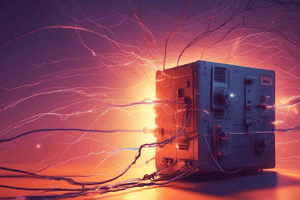Podcast
Questions and Answers
Which instrument is specifically used to measure current in a circuit?
Which instrument is specifically used to measure current in a circuit?
- Ohmmeter
- Ammeter (correct)
- Multimeter
- Voltmeter
What does current in a circuit primarily depend on when components are added or changed?
What does current in a circuit primarily depend on when components are added or changed?
- The type of battery used
- The color of the components
- The resistance in the circuit (correct)
- The length of the wires
In a series circuit, how does the current behave when additional resistors are added?
In a series circuit, how does the current behave when additional resistors are added?
- It decreases (correct)
- It fluctuates randomly
- It increases
- It remains the same
What happens to current in parallel circuits when one branch is removed?
What happens to current in parallel circuits when one branch is removed?
Which of the following describes how objects become charged?
Which of the following describes how objects become charged?
What occurs when two similarly charged objects are brought together?
What occurs when two similarly charged objects are brought together?
What defines the term 'gravitational field strength'?
What defines the term 'gravitational field strength'?
How can the pattern of current be distinguished in series versus parallel circuits?
How can the pattern of current be distinguished in series versus parallel circuits?
Which factor is NOT typically associated with leading to extinction?
Which factor is NOT typically associated with leading to extinction?
What is the process by which organisms evolve called?
What is the process by which organisms evolve called?
What evidence did Darwin primarily use to support his theory of natural selection?
What evidence did Darwin primarily use to support his theory of natural selection?
How can a lack of biodiversity affect an ecosystem?
How can a lack of biodiversity affect an ecosystem?
What is an endangered species?
What is an endangered species?
What is captive breeding?
What is captive breeding?
Which of the following is a consequence of extinction?
Which of the following is a consequence of extinction?
What is one technique used to prevent extinction?
What is one technique used to prevent extinction?
What is the correct relationship between DNA, genes, and chromosomes?
What is the correct relationship between DNA, genes, and chromosomes?
How do chromosomes from both parents contribute to offspring?
How do chromosomes from both parents contribute to offspring?
Why do gametes have 23 chromosomes while body cells have 46?
Why do gametes have 23 chromosomes while body cells have 46?
What is a mutation?
What is a mutation?
What does the term 'oxidation' refer to in chemical reactions?
What does the term 'oxidation' refer to in chemical reactions?
What can be inferred about the position of an element in the periodic table?
What can be inferred about the position of an element in the periodic table?
Which statement accurately describes typical properties of metals?
Which statement accurately describes typical properties of metals?
What happens during an oxidation reaction when metals react with oxygen?
What happens during an oxidation reaction when metals react with oxygen?
What is the primary product when a metal reacts with an acid?
What is the primary product when a metal reacts with an acid?
Which of the following accurately describes potential difference in a series circuit?
Which of the following accurately describes potential difference in a series circuit?
What distinguishes non-metal oxides from typical metal oxides?
What distinguishes non-metal oxides from typical metal oxides?
If the resistance of a component increases in a series circuit, what is the expected effect on the total resistance?
If the resistance of a component increases in a series circuit, what is the expected effect on the total resistance?
What happens to the reactivity of metals with acids when temperature is increased?
What happens to the reactivity of metals with acids when temperature is increased?
Which statement correctly compares series and parallel circuits?
Which statement correctly compares series and parallel circuits?
When interpreting a word equation, which of the following describes the role of the arrow?
When interpreting a word equation, which of the following describes the role of the arrow?
Which of the following is an indicator of a chemical change in metals?
Which of the following is an indicator of a chemical change in metals?
Flashcards are hidden until you start studying
Study Notes
Measuring Current
- An ammeter is used to measure the current in a circuit.
Current and Circuit Components
- The current in a circuit is primarily dependent on the voltage applied and the resistance of the components.
Parallel Circuits
- In parallel circuits, removing one branch will decrease the total current, but the current in the remaining branches will remain the same.
Series Circuits
- In a series circuit, adding more resistors will increase the total resistance and decrease the current.
Charging Objects
- Objects become charged by gaining or losing electrons.
Interaction of Charged Objects
- When two similarly charged objects are brought together, they repel each other.
Gravitational Field Strength
- Gravitational field strength is defined as the force of gravity per unit mass.
Current Patterns in Circuits
- In series circuits, current flows through each component in a single path.
- In parallel circuits, current splits into multiple paths, allowing each branch to experience its own current flow.
Extinction Drivers
- Habitat loss, climate change, pollution, and invasive species are some key drivers of extinction.
Evolution
- The process by which organisms evolve is called natural selection.
Darwin’s Theory of Evolution
- Darwin primarily used fossil evidence, anatomical similarities, and geographic distribution of species to support his theory of natural selection.
Biodiversity and Ecosystems
- A lack of biodiversity can lead to ecosystem instability, making them more vulnerable to disruptions and decline.
Endangered Species
- An endangered species is a species that is at risk of extinction in the wild.
Captive Breeding
- Captive breeding programs aim to increase the population of endangered species in controlled environments.
Consequences of Extinction
- Extinction leads to a loss of biodiversity and disrupts ecological balance.
Preventing Extinction
- Habitat conservation, species protection laws, and captive breeding programs are some techniques used to prevent extinction.
DNA, Genes, and Chromosomes
- DNA contains the genetic instructions for an organism.
- Genes are segments of DNA that code for specific traits.
- Chromosomes are structures within the nucleus made of DNA that carry genes.
Parental Contribution to Offspring
- Chromosomes from both parents contribute to offspring through fertilization, where a sperm cell from the father fuses with an egg cell from the mother.
Number of Chromosomes
- Gametes (sperm and egg cells) have 23 chromosomes, while body cells (somatic cells) have 46 chromosomes.
- This difference is due to meiosis, which halves the number of chromosomes in gamete formation.
Mutations
- A mutation is a permanent change in the DNA sequence, which can alter a gene's function.
Oxidation
- In chemical reactions, oxidation refers to the loss of electrons by a substance.
Periodic Table and Element Properties
- The position of an element in the periodic table provides information about its electron configuration, reactivity, and other properties.
Properties of Metals
- Metals are typically good conductors of heat and electricity, malleable, ductile, and have a lustrous appearance.
Metal Oxidation
- When metals react with oxygen, oxidation occurs, forming metal oxides which are often solid compounds.
Metal Reactions with Acids
- The primary product when a metal reacts with an acid is a salt and hydrogen gas.
Potential Difference in Series Circuits
- In a series circuit, the potential difference (voltage) is divided among the components, meaning the sum of the individual voltage drops equals the total voltage applied.
Non-Metal and Metal Oxides
- Non-metal oxides are typically acidic, while metal oxides are typically basic.
Resistance and Series Circuits
- If the resistance of a component increases in a series circuit, the total resistance of the circuit will also increase.
Reactivity of Metals with Acids
- Increasing temperature generally increases the rate of reaction between metals and acids.
Series and Parallel Circuits
- Series circuits have a single path for current, while parallel circuits have multiple paths.
Word Equations
- In a word equation, the arrow indicates the direction of the reaction or process.
Chemical Changes in Metals
- Color change, gas production, and formation of a precipitate are indicators of a chemical change in metals.
Studying That Suits You
Use AI to generate personalized quizzes and flashcards to suit your learning preferences.




